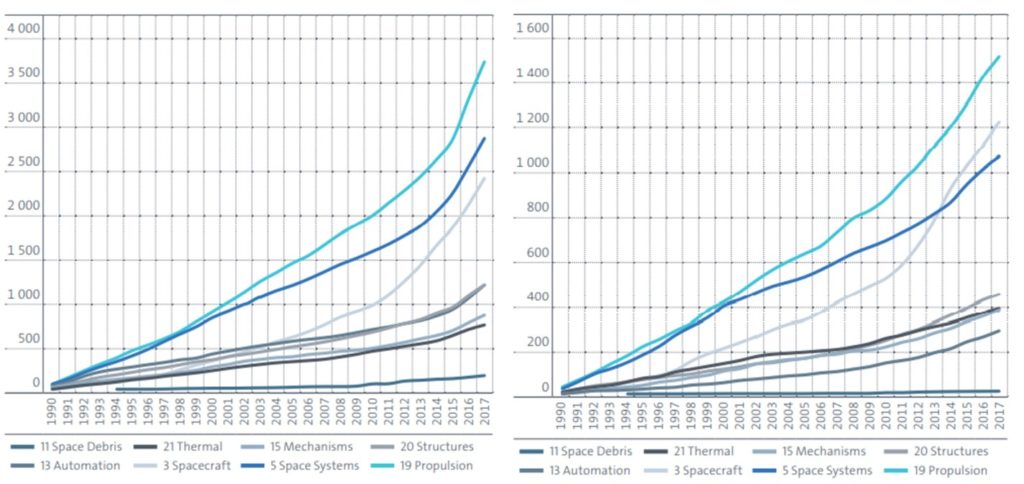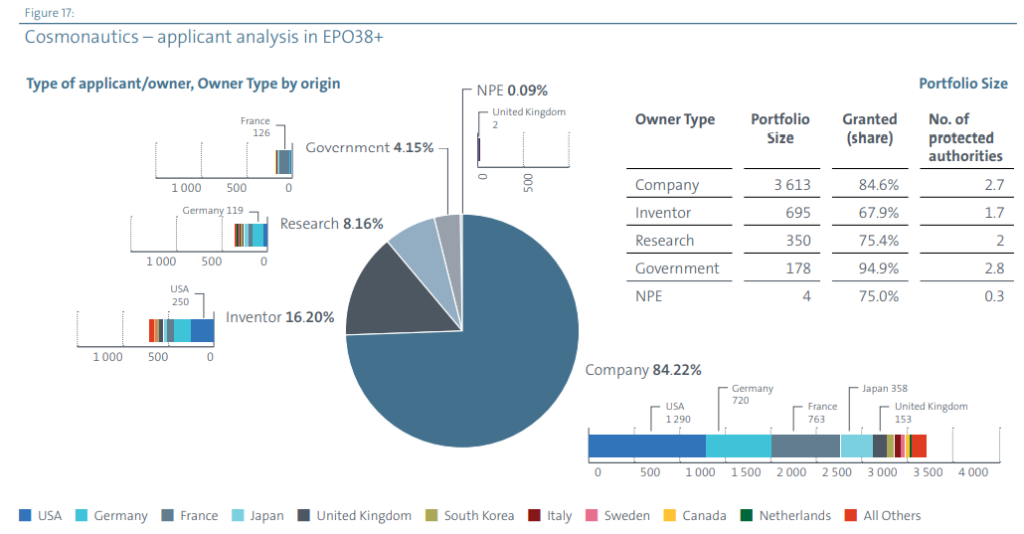23/08/2021
Introduction
On the 21st July 2021, the European Patent Office (EPO) and the European Space Policy Institute (ESPI) with the support of the European Space Agency (ESA) released a study on patent filing statistics within the field of cosmonautics. The report comes at an appropriate moment in history given the massive growth in global space activity in the last few years, including by private companies. For example, about 2000 Internet satellites have been launched into orbit over the past 2 years, nearly doubling the number of active satellites. The report highlights the development of the space sector into a more business and innovation-oriented ecosystem, commonly referred to as New Space. Patent filing activity has been steadily growing worldwide and patent filing statistics can provide indicators to measure innovation, commercialisation and knowledge transfer trends in a sector.
Patent filing trends
The report identified 11649 patent families in the field of cosmonautics, with more than a third of the total worldwide figure (4246) attributable to filings in Europe. Cosmonautics has experienced a significant growth in patenting activity with a noticeable upsurge in the last five years. European statistics show on average a higher number of patent rights per family, with players seeking patent protection in multiple European countries. In contrast, only roughly 5% of patent filings originating in China are filed outside China with more than 2100 inventions with only a single patent right (in China). Therefore, a surge of activity in China has led to a higher rate of increase in cosmonautics patent filings worldwide than in Europe – because most patents filed in China are not also filed in Europe, and so are only included in the worldwide count. It must be noted that this is not an isolated trend but is visible in other technology fields with China accounting for nearly half of total global patent filings in 2018 with 1.54 million applications.
Figures 1 and 2 display the overall trend in terms of the number of cosmonautics patent applications and families, worldwide and in Europe, over the past 30 years. Increasing patent filing activity both in Europe and worldwide indicates that cosmonautics is a maturing market with contributing players increasingly looking to protect their intellectual property.


The report also considered the country of origin of inventors in the space sector, which is summarised below. European innovators in the space sector are generally located in either Germany or France, which is unsurprising given that these countries have the highest space budgets in Europe. However, the UK, Italy, Sweden, Spain, the Netherlands and Switzerland are also active players. Generally speaking, cosmonautic patenting activity in Europe is almost exclusively produced by the 22 ESA member states. Notable filing activity in Europe by US, Japanese and Korean companies can also be seen. However, the statistics show that Russian and Chinese players are far less likely to file in Europe.

The filing statistics in the report are broken down into eight technology domains: propulsion, structures, space systems control, mechanisms, spacecraft electrical power, thermal, space debris and AT&R (automation, telepresence & robotics). These domains represent the most essential technologies for controlling and operating a spacecraft during its mission. Figure 4 shows patent filing data for each technology domain. The report data show a sharp increase after 2011 with the largest activity worldwide coming from the propulsion domain. In Europe, the number of applications for all eight cosmonautics technology domains was generally two to three times higher in 2016 than in 2006. However, worldwide the increase per domain was generally fourfold which is likely attributable to a surge of activity in China.

Player analysis
Owner-type analysis can be used as a measure of the degree of maturity of a technology. For example, when the share of patents held by academic institutions in a field is low (<1-5%), this is often an indication of an established market with only company players remaining. In areas of significant interest to governments, there is often a high proportion of academic or governmental players.
The owner-type analysis in this study contains some self-confessed inconsistencies. In the case of Russia and China, “university” in an applicant’s name leads to classification as academia. State organisations such as Roscosmos are classified as a “company”. Conversely, the ESA and NASA are both classified as “research”. The report shows that there is a high number of Chinese patents that originate in academia and research institutions. For companies filing in Europe, the dominant positions of France and Germany are apparent. In the case of Germany, patents owned by the German Aerospace Centre (DLR) are included in the “research” category, whereas patent applications filed by the National Centre for Space Studies (CNES) are owned by the French Government. There is a high percentage of company filed patents (84.2%) in Europe, which indicates a mature market for space.


The report shows that the majority of the top players in Europe are companies. Just 6 of the top 15 players in patent filings in Europe are based in Europe, with the rest being mainly US and Japanese companies. Their interest in filing for patent rights in Europe suggests the importance attributed to European space markets. 13 of the top 15 players filing cosmonautics patent applications are either European companies (Airbus, Thales, Safran), US companies (Boeing, Northrop Grumman, Maxar Technologies, Aerojet Rocketdyne, GM, etc.) or Japanese companies (Toyota). The other two are the French Government/CNES and the DLR.
Businesses outside the space sector are increasingly entering the cosmonautics field. The emergence of companies such as Bosch or Toyota is due to the increasing demand for battery technology in the space environment. The statistics show an increasing rate of spin-in – where companies outside the space sector enter the space field.
The leading player worldwide and in Europe is a European company – Airbus. Recently, however, patent filings by the China Aerospace Science and Technology Corporation (CASC) have risen dramatically. The overwhelming majority of patent families are concentrated in the hands of several major players: Airbus, CASC, Boeing, Safran and Lockheed Martin. However, the presence of a variety of smaller players suggests opportunities for smaller European players, including start-ups and SMEs, to enter the cosmonautics field.
Summary
The report highlighted five key findings which are shown below:
- There has been a steep worldwide growth in patent filing in cosmonautics in the past decade, with European activity contributing to this trend.
- European patent filing activity is primarily driven by Germany, France and other ESA member states.
- 84.2% of cosmonautics patents in Europe are company owned.
- A significant share of patents filed in Europe are from non-European countries, indicating Europe as a key market for non-European players.
- The patent filing statistics show that new players are continuously entering the cosmonautics field, including non-space actors.
Here are Reddie & Grose LLP, we have the specialist knowledge and experience to ensure that inventions in the field of cosmonautics are protected in the best possible way for our clients. If you have a space based invention, or would like more information, please contact a member of our team.
This article is for general information only. Its content is not a statement of the law on any subject and does not constitute advice. Please contact Reddie & Grose LLP for advice before taking any action in reliance on it.


